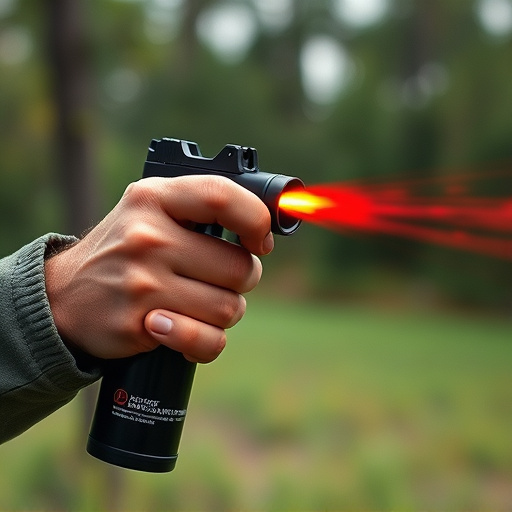Understanding the mechanics of pepper spray reveals crucial differences between indoor and outdoor use. Outdoors, wind affects range and accuracy, while indoors, space limitations reduce effectiveness. Selecting the right pepper spray requires considering environment: strong, long-range formulas for outdoor defense and milder, shorter-range options for indoor safety. Tailoring choices to specific settings ensures optimal self-protection.
Staying safe is a top priority, especially when facing unexpected threats. In this comprehensive guide, we explore tactical pepper spray as a powerful tool for self-protection. From understanding its active ingredients to mastering application techniques, we demystify this defense mechanism. We delve into the distinct needs of indoor and outdoor scenarios, highlighting key differences between these environments. Additionally, learn how to choose the right pepper spray tailored to your specific requirements, ensuring peace of mind in any setting.
- Understanding Pepper Spray: A Comprehensive Overview
- Pepper Spray for Indoor vs Outdoor Self-Protection: Key Differences
- Choosing the Right Tactical Pepper Spray for Your Needs
Understanding Pepper Spray: A Comprehensive Overview
Pepper spray, a powerful self-defense tool, has become an essential addition to personal safety kits for individuals seeking protection both indoors and outdoors. Understanding its mechanics and effectiveness is crucial when considering its use. Pepper spray operates by delivering a potent blend of capsaicin, the compound responsible for the burning sensation in chili peppers, into the eyes and respiratory system of a perceived threat. This irritant causes temporary blindness, coughing, and difficulty breathing, providing users with critical seconds to escape or incapacitate the attacker.
The effectiveness of pepper spray varies based on factors such as distance, weather conditions, and the target’s tolerance. When used outdoors, wind direction plays a significant role in its range and accuracy. In contrast, indoor usage requires careful consideration due to limited space and potential for reduced impact if the spray cannot reach the attacker effectively. Understanding these nuances is vital for users to deploy pepper spray strategically, ensuring its maximum effectiveness in diverse environments.
Pepper Spray for Indoor vs Outdoor Self-Protection: Key Differences
When considering pepper spray for self-protection, understanding the key differences between indoor and outdoor use is essential. Pepper spray designed for outdoor use is generally more potent and offers a longer range due to its ability to dissipate quickly in the open air. This makes it ideal for situations where you might need to defend yourself against an attacker at a distance or in a spacious area. Conversely, indoor pepper spray is formulated to be less irritating and have a shorter reach. This is because the smaller, confined spaces of homes or public buildings allow for the spray’s active ingredients to linger, potentially causing more discomfort to bystanders or damaging property.
The differences extend beyond just potency and range. Indoor pepper sprays often come with features like safer actuation mechanisms to prevent accidental discharge in close quarters, while outdoor sprays might prioritize robust construction to withstand harsh weather conditions. Thus, when choosing between a pepper spray designed for indoor or outdoor self-protection, consider the specific environment where you’ll need it most, ensuring you’re equipped with the right tool for the job.
Choosing the Right Tactical Pepper Spray for Your Needs
When choosing a tactical pepper spray, understanding the difference between indoor and outdoor usage is crucial. Pepper sprays are designed for various environments, and their effectiveness can vary significantly based on factors like wind speed, humidity, and temperature. For indoor use, consider sprays with a shorter range but higher concentration to ensure maximum impact in confined spaces. These typically have a stronger pepper oil content, aiming to incapacitate quickly without requiring long-range accuracy.
In contrast, outdoor tactical pepper spray should offer greater reach and longevity. Look for models designed to withstand wind and environmental factors while maintaining potency. Features like a longer range, weather-resistant construction, and a balanced formula that’s effective in various conditions are ideal for outdoor scenarios. Always consider your specific needs and the environments you’ll be facing when selecting the right tactical pepper spray.
When it comes to tactical pepper spray, understanding its application in both indoor and outdoor scenarios is key. The choice between a spray designed for one environment over the other depends on factors like range, concentration, and usage frequency. For indoor use, consider sprays with shorter ranges but higher concentrations, ideal for close-quarters defense against aggressive assailants. Outdoor scenarios demand sprays with longer ranges and lower concentrations to handle unexpected threats from farther distances. Choosing the right pepper spray ensures you’re prepared for any situation, providing an effective self-protection tool that can give you the time and space needed to escape dangerous encounters.
